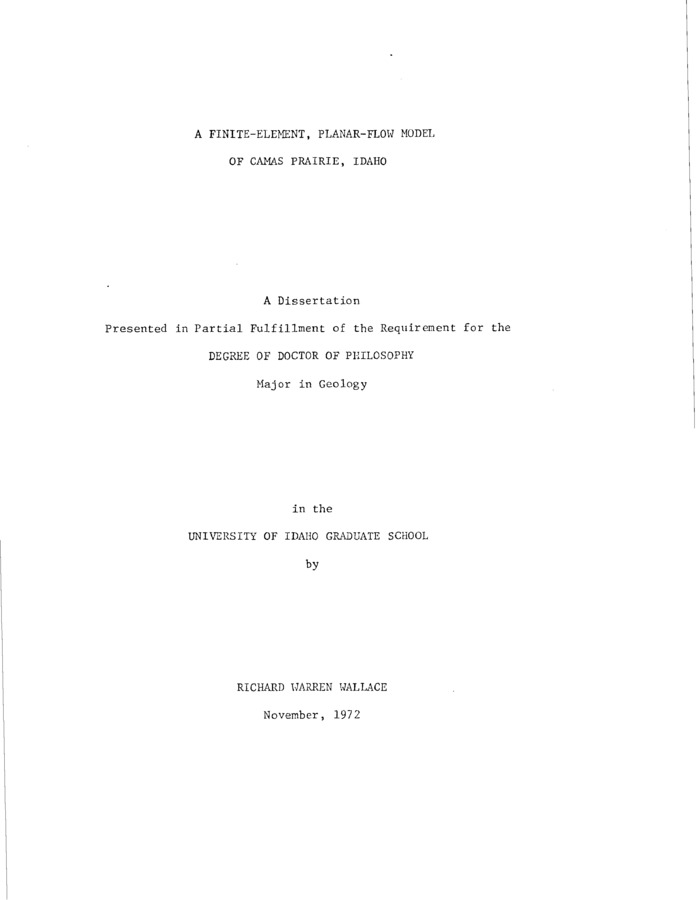PDF
A finite-element, planar-flow model of Camas Prairie, Idaho Item Info
- Title:
- A finite-element, planar-flow model of Camas Prairie, Idaho
- Authors:
- Wallace, Richard Warren;
- Date Created (ISO Standard):
- 1972-11
- Description:
- Modern digital computers and mathematical models have been applied to fluid flow problems since the 1960's. Through the use of these tools, problems can be approached where the solutions at discrete points within the field of interest are sufficient. In this study a finite-element, planar-flow model was applied to a groundwater basin in southern Idaho, using a program developed by Dr. R. L. Taylor of the University of California at Berkeley. The area studied is an intermontane valley in Carnas and Elmore counties, Idaho, and consists of a prairie of valley-fill material that partially fills a valley about 30 miles long and 8-10 miles wide. The valley sides and surrounding areas are composed mainly of igneous and volcanic rocks that are relatively impermeable. The basement rock beneath the valley floor is assumed to be of the same material as the sides . The groundwater system consists of a shallow water table aquifer, a clay unit and 2 artesian aquifers separated by relatively impermeable silty clay. The model program is fitted to the geologic and hydrologic conditions of the area. A finite-element mesh is developed corresponding to a geologic section parallel to the valley axis. Input parameters to the model program are annual precipitation, permeabilities of the various units, boundaries and the geometric positions of positions of the mesh nodes with reference to a spatial coordinate system. The program computes head, potential, flow velocities in 2 directions normal to each other, resultant flow velocity and resultant flow direction with respect to the coordinate system, for each element in the mesh. The model seems to give an adequate representation of the groundwater system of the basin, based on comparison of computed hydraulic heads with actual measurements of water levels and artesian heads. Flow quantities are computed for underflow at the output end of the section, using average annual precipitation as input. Underflow is also computed for simulated situations of 3 and 6 inches more than and less than average annual precipitation. Changes in underflow equivalent to 4-0.03 and -0.05 feet of water input indicate that the artesian aquifers are essentially insulated from changes in annual precipitation in any given year. This type model should have practical use not only for describing a flow system but also for simulating past, future and/or locally changed conditions.
- Subjects:
- groundwater basins groundwater flow finite element method plane flow
- Location:
- Camas Creek
- Latitude:
- 43.33
- Longitude:
- -115.73
- IWRRI number:
- 197221
- Rights:
- In copyright, educational use permitted. Educational use includes non-commercial reproduction of text and images in materials for teaching and research purposes. For other contexts beyond fair use, including digital reproduction, please contact the University of Idaho Library Special Collections and Archives Department at libspec@uidaho.edu. The University of Idaho Library is not liable for any violations of the law by users.
- Publisher:
- University of Idaho
- Contributing Institution:
- University of Idaho
- Type:
- Text
- Format:
- application/pdf
- Cataloger:
- wbv
- Date Digitized:
- 2012
Source
- Preferred Citation:
- "A finite-element, planar-flow model of Camas Prairie, Idaho", Idaho Waters Digital Library, University of Idaho Library Digital Collections, https://www.lib.uidaho.edu/digital/iwdl/items/iwdl-197221.html
Rights
- Rights:
- In copyright, educational use permitted. Educational use includes non-commercial reproduction of text and images in materials for teaching and research purposes. For other contexts beyond fair use, including digital reproduction, please contact the University of Idaho Library Special Collections and Archives Department at libspec@uidaho.edu. The University of Idaho Library is not liable for any violations of the law by users.
- Standardized Rights:
- http://rightsstatements.org/vocab/InC-EDU/1.0/

